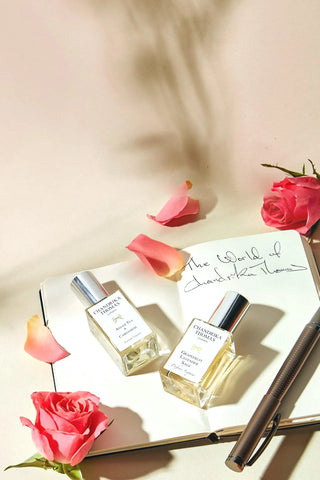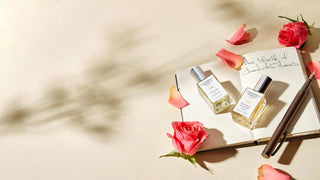How long can fragrance last and remain as captivating as the first moment it touches your skin? It’s not just about the perfume itself, it’s about how it interacts with you and the world around you. A fragrance doesn’t simply linger because it’s applied; it stays because of the complex interplay between its ingredients, the unique chemistry of your skin, and the environment in which it exists.
Some scents seem to fade within hours, while others seem to live on, echoing throughout the day. Understanding fragrance longevity is essential for anyone who wishes to appreciate how a scent evolves, endures, and leaves its mark on the world. In this note, we’ll explore the reasons why certain perfumes last longer than others and how different factors shape their lasting power.

What Is Fragrance Longevity?
Fragrance longevity refers to the length of time a perfume remains perceptible on the skin or in the air after application. A well-constructed fragrance unfolds in stages, beginning with its bright and ephemeral top notes, deepening into its heart, and finally settling into the lasting embrace of its base. The chemistry behind this process is a delicate balance of volatility, molecular weight, and the interaction between fragrance compounds and external influences.
Some perfumes vanish within a few short hours, while others linger effortlessly for an entire day. This variance is not accidental; it is a result of numerous factors that influence how fragrance interacts with its surroundings.

Factors That Influence How Fragrance Can Last
Skin Type:
The way a fragrance unfolds and stays with you is deeply linked to the nature of your skin.
Dry Skin: For dry skin, fragrances may tend to fade faster. This is because dry skin doesn't naturally retain oils, which are essential for holding onto the scent molecules. As a result, the fragrance can dissipate more quickly, leaving the scent less noticeable after a few hours. You may find yourself needing to reapply to maintain the same intensity.
Oily Skin: On the other hand, those with oily skin often notice that fragrances last longer. The natural oils in the skin act like a base, helping the fragrance adhere and last through the day. These oils hold the scent molecules in place, resulting in a more enduring and even diffusion of the fragrance.
Just as a canvas alters the final result of a painting, the unique chemistry of your skin moulds how a fragrance behaves and how long it lingers, making the experience of scent personal and dynamic.

Environmental Factors:
How long fragrances last can also be affected by external conditions, including humidity, temperature, and air quality.
-
Humidity: In humid climates, perfumes tend to last longer, as the moisture in the air slows the evaporation of scent molecules. The fragrance lingers, unfolding gracefully as it mingles with the surrounding atmosphere.
-
Temperature: Heat accelerates evaporation, meaning that in warm weather, fragrances may dissipate more quickly. Conversely, in cooler conditions, perfumes tend to last longer, as the evaporation process is slowed. Winter fragrances, often rich with warm, resinous notes, thrive in cold air, revealing their complexity over time.
-
Air Quality: The presence of pollutants or strong competing scents in the air can also affect how a fragrance is perceived. Clean, open air allows a perfume to radiate naturally, while a dense, heavily scented environment may mute or alter its character.
Much like a melody changes when played in different spaces, softly resonant in a quiet room, but lost in the noise of a crowd, a fragrance interacts with its surroundings, adapting to the conditions in which it exists.

Fragrance Composition:
A fragrance is a symphony of notes that unfold in a structured manner, and its longevity is largely dictated by its composition.
-
Top Notes: These are the lightest and most volatile molecules, creating the initial impression of the fragrance. Often composed of citrus, green, or aquatic elements, they evaporate quickly, usually within the first 15–30 minutes.
-
Middle Notes: Also known as the heart of the fragrance, these notes emerge once the top notes fade. Florals, spices, and fruit accords commonly define this stage, lasting for several hours as the scent evolves on the skin.
-
Base Notes: The foundation of a fragrance, base notes contain the heaviest molecules, which linger the longest. Deep woods, musks, amber, vanilla, and resins create a lasting presence, sometimes remaining detectable for an entire day or more.
The presence of fixatives, ingredients that slow down the evaporation of volatile notes, also plays a role in how fragrance can last. Natural fixatives like sandalwood, benzoin, and labdanum, or synthetic fixatives such as Ambroxan, enhance longevity by stabilising the more delicate top and heart notes.
Each perfume is a carefully composed journey, and its lasting power is determined by the balance of these elements, ensuring that the scent unfolds with elegance and grace.

Application Methods: How Application Impacts Fragrance Longevity
The way a fragrance is applied has a considerable influence on how long it lasts and how it's experienced throughout the day.
Pulse Points: Key areas of the body such as the wrists, neck, and behind the ears naturally produce more warmth. This warmth helps diffuse the scent and enhances its projection. These areas act as gentle diffusers, allowing the fragrance to develop and linger with ease as the day progresses.
Hair and Clothing: While your skin interacts directly with the perfume, your clothes and hair offer an alternate method of scent retention. Fragrance adheres differently to fabric and hair, often lasting longer because these surfaces don't naturally emit heat as the skin does. Applying perfume to these areas can leave a soft, enduring scent that doesn’t dissipate as quickly as it might on bare skin.
Fragrance application is a subtle art that allows us to tailor the way a scent unfolds throughout the day. Whether you choose to spritz it on pulse points for a stronger projection or apply it lightly on clothing or hair for a more restrained, yet lasting aroma, each method offers a distinct way to experience the perfume.

Fragrance longevity is a delicate interplay of art and nature, where the perfume’s composition, your skin’s unique chemistry, and the environment it breathes in all merge to shape how long fragrance lasts on you. It’s not only the duration that matters, but the way a fragrance unfolds, weaving its story across the hours. From the fleeting brightness of the top notes to the deep, lasting warmth of the base, each moment with a fragrance is a gentle transformation.
By understanding the intricate factors that affect fragrance longevity, you can begin to truly appreciate its evolving nature. A scent becomes an intimate part of you, lingering softly in the air and marking the moments of your day. When you embrace this understanding, you’ll find that your fragrance doesn’t just accompany you; it leaves an indelible impression, woven into your essence, long after the last note fades.



